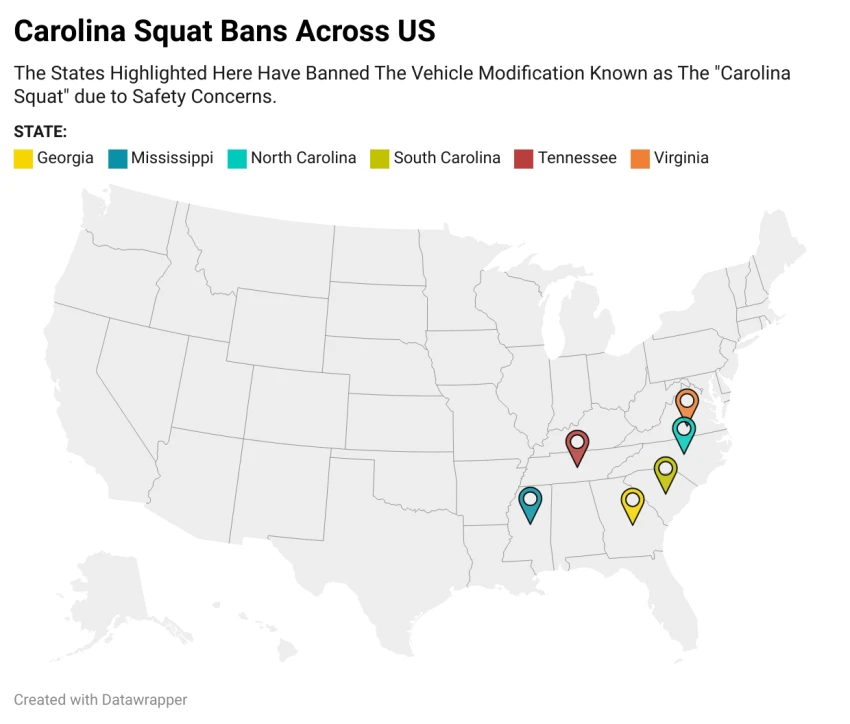Recent data unearthed by Farmer & Morris revealed that a vehicular modification known as the “Carolina Squat” has seen increasing backlash. This popular modification allows drivers to lift the front of their vehicles, regardless of the vehicle’s make or model, courtesy of suspension lifting kits.
This modification makes the average car look like it’s “squatting,” leading to the name.
Despite its interesting appearance, the Carolina Squat poses an actual danger to people on the road. North Carolina, South Carolina, Virginia, Georgia, Tennessee, and Mississippi have all prohibited cars modified in the Carolina Squat style from operating on public roads.

Where did the Carolina Squat Come from?
While the name “Carolina Squat” might make you think the modification trend originated in either North or South Carolina, it actually has its roots in California. Baja Racing vehicles often had lower backends, improving their appearance and making it easier for the racers to jump sand dunes.
The lower-end suspension made it safer for Baja racers to land their vehicles safely. It’s thanks to the modification’s affiliation with the high-speed, stunt-driving tactics of these racers that the Carolina Squat caught on. Nowadays, the Squat has a place in vehicular history as a functional and aesthetically interesting modification.
However, there’s a stark difference between a Squat’s functionality on sand dunes and its place on public roads.
Why Is the Carolina Squat Dangerous?
The Carolina Squat’s lifted suspension raises a car’s center of gravity and distributes a car’s weight to make it manage jumps more efficiently. However, the average driver isn’t regularly re-enacting the stunts from today’s Fast and Furious movies. The Carolina Squat’s distribution of weight dramatically increases a car’s chance of rolling on interstates and local roads.
Likewise, the Squat raises a car’s headlights so they’re pointed skyward – or, more frequently, directly into the eyes of oncoming drivers. Sudden road blindness can lead to devastating accidents.
What’s more, some motorists have taken the modification process involved in the Carolina Squat a step further by investing in larger wheels and tires. These modifications compound a car’s weight, increase a car’s stopping distance, and make it harder to stop in dangerous weather.
Personal Injury Lawyer Near Me 828.286.3866
Does a Carolina Squat Modification Make Crashes More Dangerous?
Cars modified to take on the Carolina Squat face a higher risk of rollovers than their unmodified cousins, but that’s not the only accident drivers may find themselves in.
Head-on collisions also become increasingly dangerous. Oncoming cars can slip beneath a suspended car, doing considerable damage to the lifted car’s undercarriage.
Rollovers and head-on collisions also put drivers and their passengers at serious risk for long-lasting injuries, including broken bones, traumatic brain injuries, spinal cord injuries, whiplash, and even paralysis.
Long-Term Vehicular Damage
The car mods involved in establishing the Carolina Squat make it so the modified car no longer follows the guidelines established by manufacturers. This means that Squatted cars can more often suffer from abrupt suspension failures, transmission failures, and even engine failures.
Additionally, the angle of a Squatted car encourages a car’s oil to flow backward, forcing the oil pump to wear itself out faster than it might in an unmodified car. Lack of lubrication stemming from an overworked oil pump can pave the way to irreparable vehicular damage and even oil fires.
Which States Have Banned the Carolina Squat?
Several states have enacted bans against the Carolina Squat over the past several years, including the following:
- North Carolina banned the Squat in 2021, stating that any car with a four-inch difference in height between the front and back bumpers may open its driver up to significant fines.
- Virginia banned the Squat in March 2022, also stating that cars may not have a difference of height between their front and rear bumpers exceeding four inches.
- South Carolina banned the Squat in November 2023 with similar guidelines, with violations resulting in fines.
- Tennessee and Mississippi both banned the Squat in July 2024 with similar four-inch guidelines and fines.
Georgia has the most flexible of today’s Carolina Squat bans. As of May 2024, the state informed drivers that they may not have more than six inches of difference between their front and rear bumpers, offering an additional two inches of flexibility compared to other states.
Professional Input Highlights the Dangers of the Carolina Squat
We broached the topic of the Carolina Squat with car mechanic Ben from Chapel Hill Tire Car Care. He had the following to say about the modification and its bans:
“The weight distribution and braking/control make it difficult to handle [a Carolina Squat]. It’s a high risk for a rollover. The headlights are going to be pointing up in the air instead of illuminating the road, which can blind oncoming drivers. Those are a lot of the risks right there.”
When asked if Chapel Hill Tire Car Care works on Squatted vehicles, Ben confirmed that the mechanics have banned Squatted cars from all of their locations.
He took a moment to speak out in support of the recent bans, calling the modifications “ridiculous and hideous” while also stating that the Squat “has no benefit to the vehicles whatsoever.”
The Future of the Carolina Squat
It remains to be seen whether or not there is a future for the Carolina Squat. There’s a chance that increased awareness about the dangers of the modification may push other states to ban or fine the Squat when it appears on public roads.
Farmer & Morris believe that everyone deserves to feel safe on the roads. Car accident victims suffering injuries after a collision in or with a Squatted Car can reach out to our team to discuss what bans apply in their state, if any, and what steps they can take to get back on their feet.



